Is the Freemium Model Right for Your Business? Understanding the Benefits and Drawbacks
In the digital economy, the freemium model has become one of the most popular strategies for attracting and retaining customers. This model has fueled the growth of companies like Dropbox, Spotify, and Canva by offering a core product or service for free while charging for premium features.
But is the freemium approach the right choice for your business?
The freemium approach can be the right choice for your business if your product offers clear value even in its free version and you can effectively convert free users into paying customers. It works well for businesses with low marginal costs and high scalability, such as digital services or software. However, it requires a substantial user base to offset costs and may not be suitable if your product’s core value is only apparent in premium features. Careful planning, a strong user acquisition strategy, and a clear conversion path are essential for success with the freemium model.
While it holds immense potential to drive user acquisition and build a loyal customer base, the model also presents unique challenges.
The freemium business model is known as the “business model of the Internet”. The term freemium combines the words ‘Free’ and ‘Premium’. The basic product is available for free. The company generates revenue by offering connected premium product, i.e. additional functions or services which usually attract a small number of users. By giving away the basic product for free it is easier to lure users and create a customer base. This business model pattern is one of the most widely used for Internet start-ups.
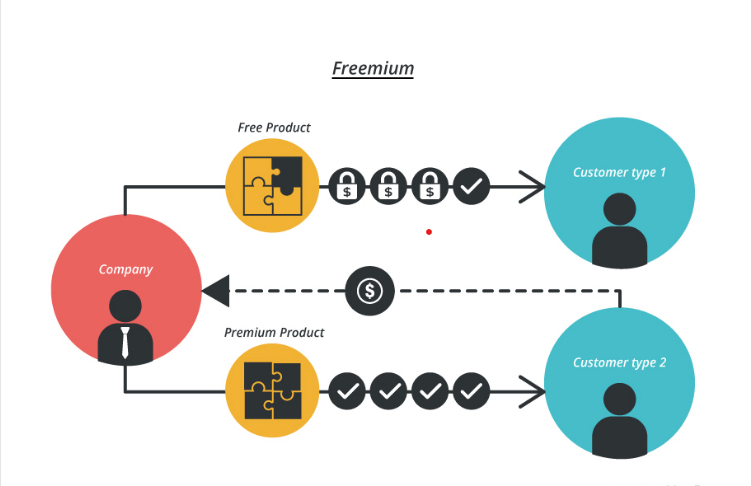
source: BMTool box
The Business Model Canvas (BMC) serves as a powerful framework to help businesses evaluate whether the freemium model aligns with their objectives. By analyzing the nine key building blocks of the BMC, businesses can design and refine a freemium model that not only attracts users but also ensures profitability and scalability. In this article, we’ll explore how the freemium model works, its benefits and drawbacks, and how the BMC can guide its implementation.
This is the framework for Business model canvas and you can also download here
https://www.strategyzer.com/library/the-business-model-canvas
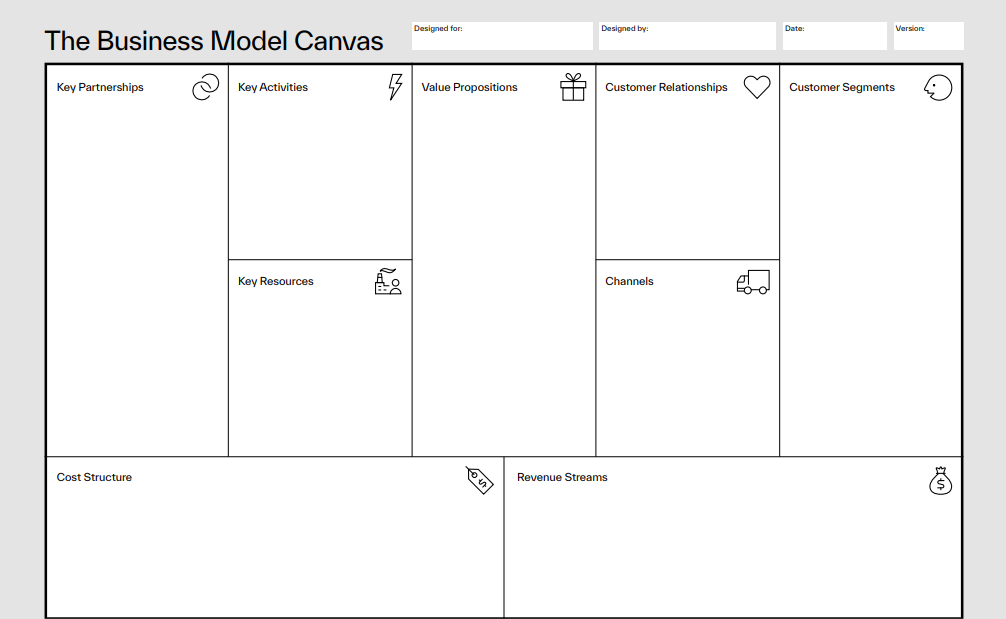
How the freemium model works?
The freemium model operates on the principle of offering a basic version of a product or service at no cost while charging for advanced features, functionalities, or exclusive content. Here’s how it typically functions:
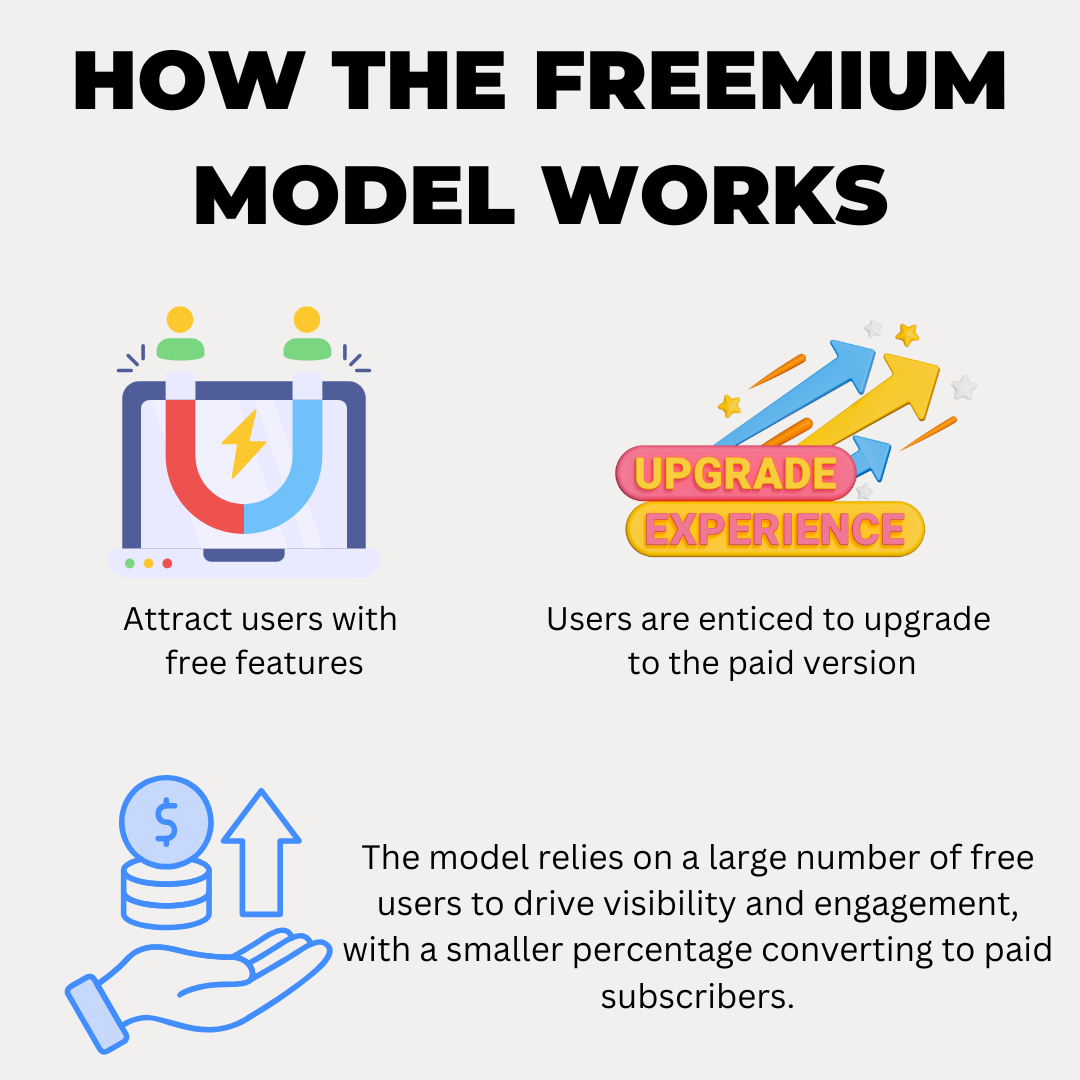
Attract users with free features:
The free version provides essential features that solve basic customer needs, encouraging a wide user base to sign up. For instance, Canva offers a robust free tier with essential design tools, enabling users to create presentations, social media graphics, and more without any cost.
Upsell premium offerings:
Users are enticed to upgrade to the paid version for enhanced capabilities, such as advanced tools, ad-free experiences, or additional storage. Dropbox’s freemium model, for example, offers a limited amount of free storage and charges for additional space, appealing to power users and businesses.
Leverage scale for profitability:
The model relies on a large number of free users to drive visibility and engagement, with a smaller percentage converting to paid subscribers. Companies like Spotify exemplify this by offering free, ad-supported music streaming to attract a massive audience while encouraging upgrades to premium for benefits like offline listening, ad-free streaming, and higher audio quality.
This tiered approach strikes a balance between accessibility and profitability, allowing businesses to grow a user base while generating revenue from those who value premium features.
Benefits of the freemium model
The freemium model offers free basic services to attract users while generating revenue through premium features. The benefits are increased user acquisition, enhanced brand visibility, customer trust, and improved engagement. This model also helps convert loyal users into paid subscribers and provides valuable insights for refining offerings.
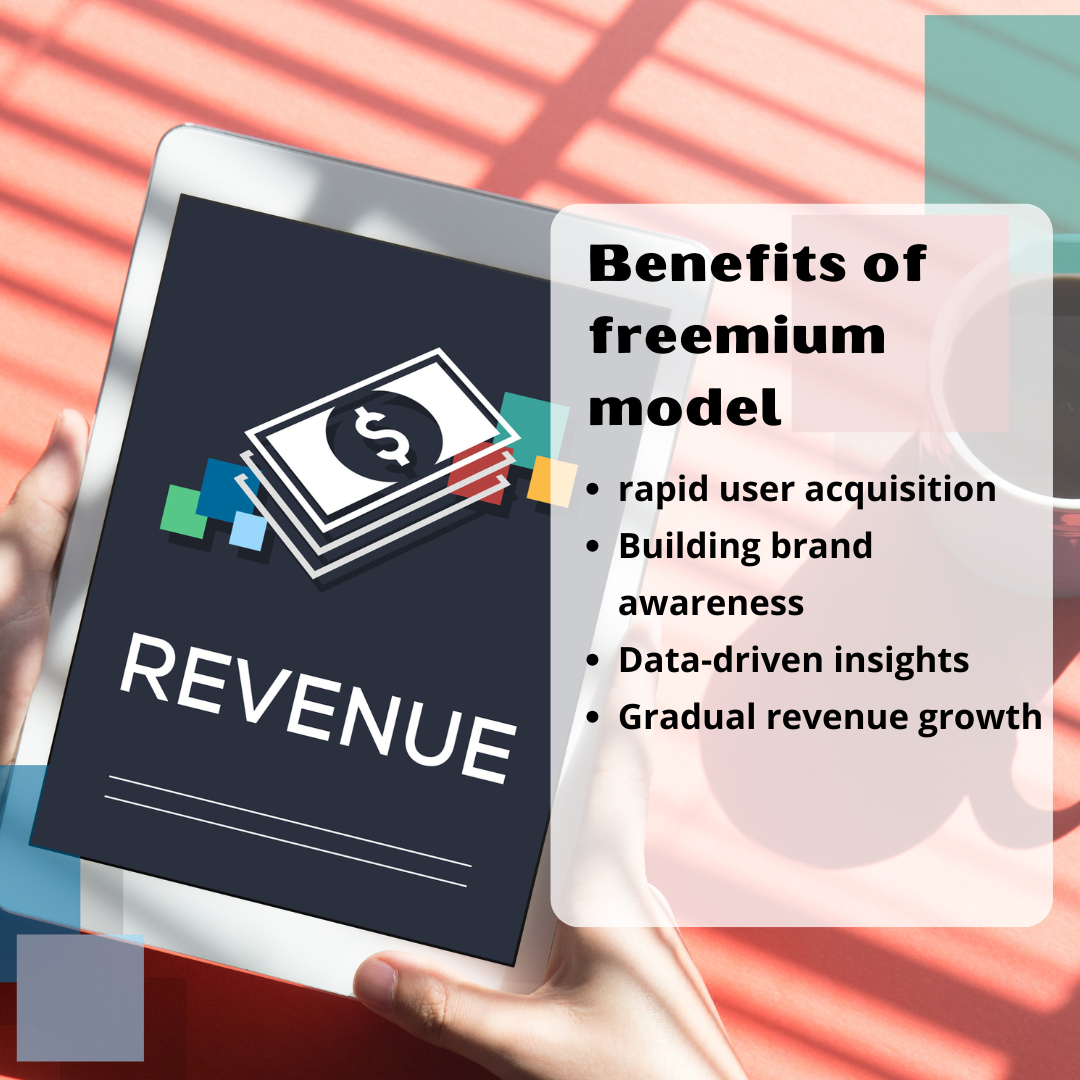
1. Rapid user acquisition:
By removing the cost barrier, the freemium model attracts a vast audience. This is particularly effective for digital platforms, where marginal costs for serving additional users are minimal. For instance, Zoom’s free plan enabled it to grow exponentially during the pandemic, creating a global user base. The ease of access and low commitment encouraged millions of users to experience the platform, setting the stage for premium upgrades.
2. Building brand awareness:
A free product acts as a marketing tool, increasing visibility and word-of-mouth promotion. Canva’s free design tools have made it a household name, with users recommending it to others due to its accessibility and ease of use. This wide adoption helped Canva establish itself as a go-to platform for graphic design, ultimately driving premium subscriptions among professionals and businesses.
3. Data-driven insights:
Freemium models provide access to a wealth of user behavior data, helping businesses understand customer preferences and optimize their offerings. For example, Duolingo leverages user data to refine lesson plans and introduce gamified features that enhance user retention. This data also informs targeted marketing efforts, nudging free users toward premium plans with personalized offers.
4. Gradual revenue growth:
While free users may not immediately contribute to revenue, a well-structured upselling strategy can convert a significant portion into paying customers over time. Dropbox’s freemium approach capitalized on this by offering limited free storage and charging for additional space. Over time, as users’ storage needs grew, many transitioned to paid plans, driving sustainable revenue growth.
Drawbacks of the freemium model
The freemium model, while popular, comes with significant challenges. It requires high user volumes to offset costs, risks undervaluing premium features, and may lead to unsustainable revenue. Additionally, converting free users to paying customers can be difficult. The following drawbacks are essential to consider for businesses adopting this model.
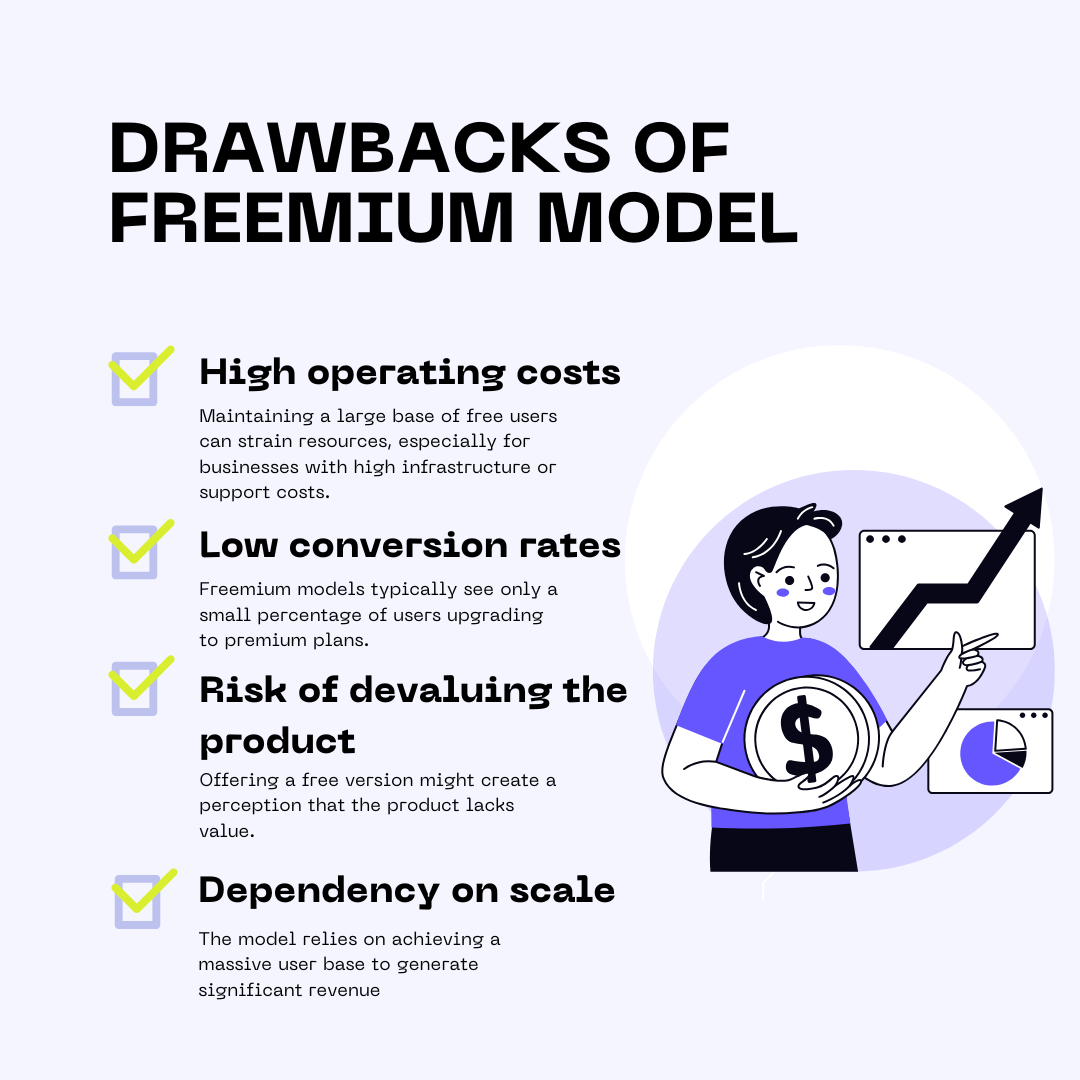
1. High operating costs:
Maintaining a large base of free users can strain resources, especially for businesses with high infrastructure or support costs. For example, providing free cloud storage incurs ongoing expenses without direct revenue from free users. Companies must carefully monitor these costs to avoid eroding profitability. Effective cost management, such as optimizing server usage and scaling support operations efficiently, is critical to overcoming this challenge.
2. Low conversion rates:
Freemium models typically see only a small percentage of users upgrading to premium plans. Businesses must design compelling incentives to boost conversion rates or risk operating at a loss. For instance, free users may resist upgrading if they perceive the free tier as meeting their needs. Tactics such as offering time-limited premium trials or exclusive features can encourage conversions.
3. Risk of devaluing the product:
Offering a free version might create a perception that the product lacks value. This risk can be mitigated by positioning the free tier as an introductory experience while emphasizing the added benefits of the premium version. Clear communication about the value of upgrading—through testimonials, feature highlights, and direct comparisons—helps address this issue.
4. Dependency on scale:
The model relies on achieving a massive user base to generate significant revenue. For startups or niche markets, scaling quickly enough to sustain the model can be challenging. Strategies like viral marketing campaigns and partnerships with established platforms can accelerate user acquisition. Without adequate growth, however, the business may struggle to cover costs and achieve profitability.
Designing a freemium model with the business model canvas
The BMC provides a structured approach to evaluate and implement the freemium model. Let’s explore its application across the nine building blocks:
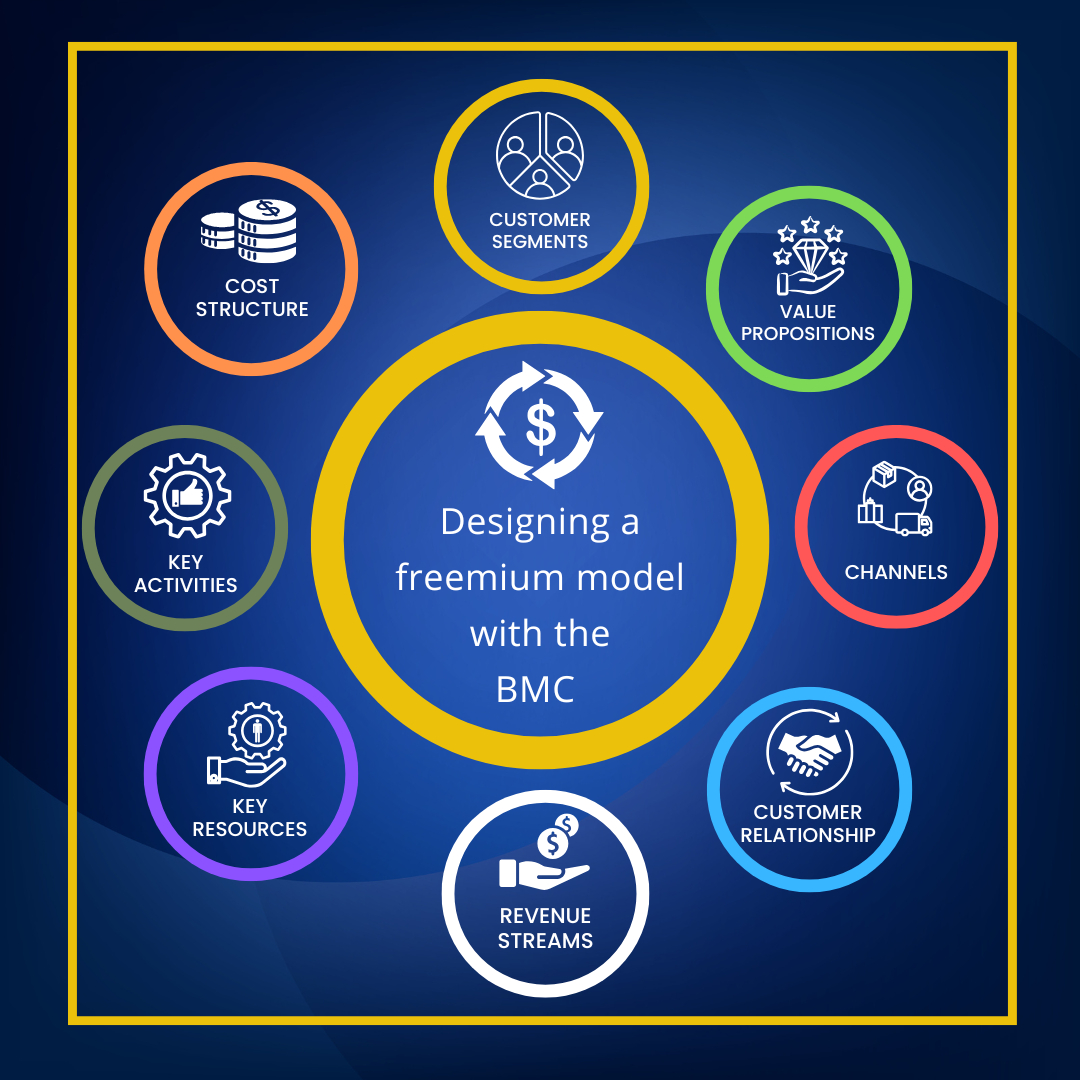
1. Customer segments:
Identify distinct user groups for your free and premium tiers. For instance, Trello’s free tier appeals to individual users and small teams, while its premium plans target larger organizations needing advanced collaboration tools.
2. Value propositions:
Clarify the unique benefits of both free and premium tiers. The free version should solve a real problem, while the premium version adds significant value. Slack’s free plan supports team communication, while its premium tiers include unlimited integrations and data retention.
3. Channels:
Choose effective channels to acquire and engage users. Digital marketing, app stores, and referral programs are common methods for freemium models.
4. Customer relationships:
Invest in fostering relationships through customer support, in-app tutorials, and community engagement. Personalized emails and push notifications can nudge free users toward premium upgrades.
5. Revenue streams:
Revenue comes primarily from premium subscriptions and, in some cases, ads shown to free users. Companies like Spotify maximize revenue by balancing these streams.
6. Key resources:
Identify resources needed to support the freemium model, such as scalable technology infrastructure, data analytics tools, and a content library.
7. Key activities:
Focus on activities like continuous product improvement, marketing campaigns, and customer retention strategies to sustain and grow the model.
8. Key partnerships:
Collaborate with partners to enhance value. For instance, LinkedIn’s premium plans integrate with third-party tools like Salesforce to provide added functionality.
9. Cost structure:
Understand the costs associated with serving free users, such as server maintenance, support teams, and marketing. Monitor these expenses to ensure profitability.
Example:
Spotify's Freemium Success
Spotify serves as a prime example of how the freemium model works effectively. The platform offers free access to its vast music library with interruptions from ads, attracting millions of users who can listen to their favorite songs without any financial commitment. However, for users who crave an uninterrupted, ad-free experience with additional features like offline listening and higher audio quality, Spotify’s premium plan provides compelling incentives to upgrade.
This two-tier system demonstrates how the freemium model balances accessibility with profitability, leveraging its free tier to build a massive user base and convert a portion into loyal, paying subscribers.
Conclusion:
Unlocking Freemium Success
The freemium model can be a game-changer for businesses aiming to scale quickly and establish market dominance. However, success depends on careful planning, ongoing refinement, and a deep understanding of customer needs. By leveraging the Business Model Canvas, businesses can design freemium strategies that balance user acquisition with long-term profitability.
Whether you’re a startup exploring freemium for rapid growth or an established company seeking to innovate, this model offers a pathway to success when executed thoughtfully. Embrace the power of freemium and watch your business thrive in today’s competitive landscape.







.png)






